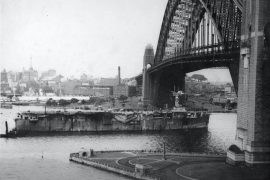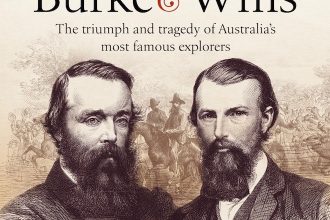
In this digital age where stories are told in a virtual space, there’s something rather nice about an exhibition that tells a story through tangible objects. And what a fascinating story it is. As its title suggests, A History of the World in 100 Objects tells an over-arching story of human history from 2 million years BCE to the present day.
The exhibition was put together by the British Museum, using objects from its extraordinary collection, and is now touring the world. It is on at the National Museum of Australia until January 29. I’d highly recommend spending a couple of hours, if not a whole morning or afternoon, viewing this wonderful exhibition before it leaves our shores.

The objects range from an African stone chopping tool, dating from at least 1.8 million years ago, through some of the world’s first coins from 2500+ years ago, to objects as recent as a credit card compliant with Islamic Sharia law (no interest can be charged).
The idea of focusing on just 100 remarkable items to tell an easy-to-comprehend story of human history came from Neil MacGregor, a former director of the British Museum. It was an enormous hit, with a best-selling book and a series of 15-minute BBC radio broadcasts adding to its popularity. Some of those broadcasts screen alongside the objects on display in the National Museum.

The exhibition is arranged chronologically in eight sections from the earliest Stone Age people through to the development of agriculture and the first cities; the development of empires; the evolution of religion; trade and invasion; Medieval times; exploration; and the industrial revolution up to the present day. Within these sections, issues as diverse as faith, power and global exploration are examined.

The objects reveal a series of compelling, and often very personal, stories. They come from around the globe and represent a vast range of materials, from stone to gold and clay to plastic. They vary in size, from a large Egyptian sculpture and a 1.6 metre tall Assyrian relief (a clay tablet inscribed with the story of a great flood and an ark, predating the story of Noah’s Ark) to a small exquisite gold llama from Peru (llamas were the Incas’ most important domestic animal and the Incas revered gold as the sweat of the sun).

It’s a journey through time and place, from an elegant bird-shaped stone pestle from Papua New Guinea, to a pair of gold Zoroastrian figures from 500BCE, to Albrecht Dürer’s celebrated print The Rhinoceros (woodcut printing allowed drawings to be mass produced), to the chronometer from Charles Darwin’s ship, The Beagle. More contemporary objects include a solar-powered lamp that has transformed the lives of many in Third World countries, and In The Dull Village, David Hockney’s 1966 etching of a male couple in bed.

“These rare objects from around the world challenge our notions of human history and throw new light on how we shaped the world in which we live – and how we continue to shape it,” said National Museum director, Dr Mathew Trinca.
Curator Dr Belinda Crerar noted that by looking closely at the things people made and used, “we gain access to those parts of our shared past that were never recorded in literature, as well as cultures that never developed the need for writing”.

One interesting point is the way in which the cultural significance of objects can change over time. The Lewis Chessmen are a classic example. Found on a beach on the Isle of Lewis in Scotland in 1831, they are carved from walrus ivory and whale tooth and date from between 1150 and 1200, when the island was part of the Kingdom of Norway.
To their original Norse owners, they would have represented wealth, prestige and power. When they were found in the 19th century, they became symbolic of the Victorian fascination for all things medieval. They found fresh fame after their inclusion in the 2001 film of Harry Potter and the Philosopher’s Stone.

Exclusive to the Australian exhibition is the bronze head of Augustus, one of the most important surviving portraits of Rome’s first emperor. Dating from 27 to 25 BCE, object number 28 was created as a symbol of Augustus’s power but later came to symbolise the fragility of empire. Seized by his enemies, it was found in the Sudan in 1911, tucked away under a flight of stairs, most likely beheaded in antiquity and deliberately placed below the victors’ feet.
“(The sculpture) speaks both of the power of Rome but also of its vulnerabilities and the difficulty of preserving that power over a vast territory,” said Trinca.

The National Museum wanted to include a 101st object in the exhibition. Indigenous Australia was already represented with a pandanus basket from Arnhem Land, and so after much debate, the museum chose the CSIRO’s prototype device that led to the development of wi-fi.
“It was the perfect thing to include as the emblem of Australia’s contribution to global history in a modern age,” said Trinca.
Exploring the past through objects such as these allows us to understand our present, and celebrate our common humanity. Mark this wonderful exhibition in your diary now.

If you go:
Where? National Museum of Australia, Canberra.
When? Until 29 January, 2017.
Extended hours 8am to 6pm daily and until 7pm Sundays.
Australia Day open 8am to midnight.
Cost? $20 adult, $15 concession, $8 child, $45 family.
Tel: 1800 026 132
More information: www.nma.gov.au





I still have to go – soon!!!
You’ll have to hurry!
We enjoyed this exhibit too.
Glad you enjoyed it, Liz. We thought it was beautifully presented.